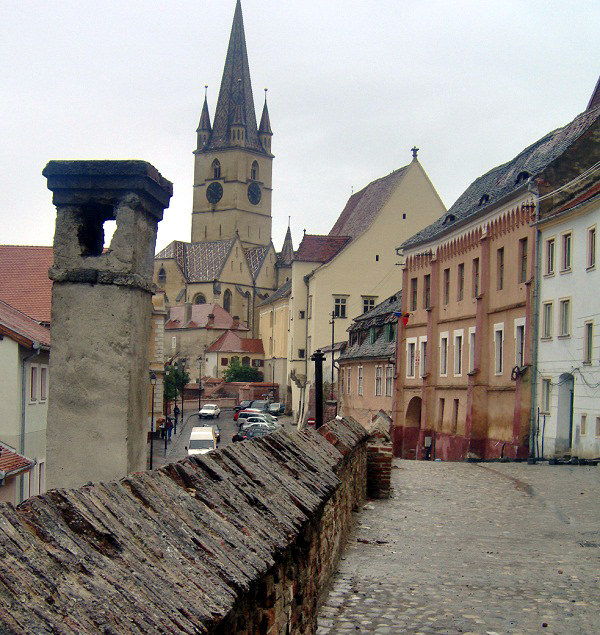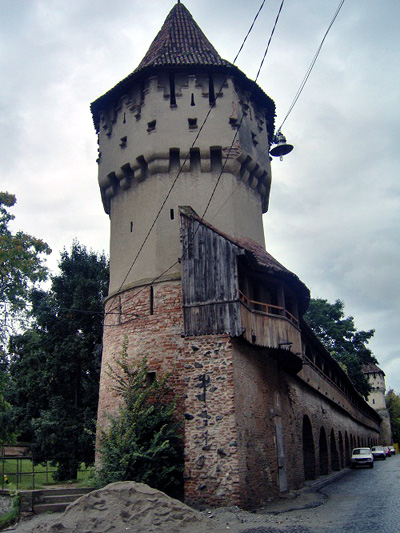Romanian cities: Sibiu, in the heart of Romania

 The heart of Romania, Sibiu or “Hermannstadt” in German and “Nagyszeben” in Hungarian, is one of the most important Romanian cultural centers. Ranked as “Europe’s 8th most idyllic place to live in”, it was also the “European Capital of Culture” in 2007, alongside with Luxembourg.
The heart of Romania, Sibiu or “Hermannstadt” in German and “Nagyszeben” in Hungarian, is one of the most important Romanian cultural centers. Ranked as “Europe’s 8th most idyllic place to live in”, it was also the “European Capital of Culture” in 2007, alongside with Luxembourg.
By Alina Andriescu
Sibiu is an old Roman settlement known under the name of Caedonia, occupied later by German settlers that knew it under the name of Cibinium. Cibin remained the name of the depression in which the city can be found and also of the river that runs through it. Sibiu became fast an important ethnic German city, together with other seven cities that gave Transilvania the name of: Siebenbürgen (seven cities).
During the 18th and 19th centuries, important changes took place. The city evolved as expected, becoming not only a very important commercial center, as the first Romanian bank “The Albina Bank” has settled its headquarters here but also became an important center for the Romanian Orthodox church, its Metropolitan seat.
After World War I, the majority of the population was still German, and even though shortly after many went back to Germany, some still remained loyal to this city. One of those who have stayed is Johannis Klaus, who is currently the city’s mayor. Sibiu also became a famous location in the novel "The Reader" (Der Vorleser) written by the German law professor and judge Bernhard Schlink. His book was turned into an Oscar-winning film (The Reader - watch the trailer here).
 In terms of transport and infrastructure, Sibiu is an important European node, connecting different routes and motorways. Intense traffic may at certain hours occur, as it lacks a city bypass. Besides the inbound traffic, Sibiu hosts the headquarters of Romanian passenger transporter Atlassib and also the international airport with direct flights to many international or local venues such as: Munich, Stuttgart, Vienna, Valencia, Cologne, Madrid, London, Bucharest and Timisoara.
In terms of transport and infrastructure, Sibiu is an important European node, connecting different routes and motorways. Intense traffic may at certain hours occur, as it lacks a city bypass. Besides the inbound traffic, Sibiu hosts the headquarters of Romanian passenger transporter Atlassib and also the international airport with direct flights to many international or local venues such as: Munich, Stuttgart, Vienna, Valencia, Cologne, Madrid, London, Bucharest and Timisoara.
Sibiu is made of two parts: the Lower Town and the Upper Town. The Lower Town is the old part of the city, an oasis of rustic architecture that exists since the earliest fortifications. The oldest church in the city, dating from 1929, can be found in this area. The city of Sibiu was one of the greatest fortifications in Central Europe. During the 16th centuries many modern elements were added to these fortification rings, like leaf –shaped bastions such as: the “Haller Bastion” and the "Soldisch Bastion", the only two which survived after the industrial development and modern urban planning in the late 19th century. The Upper Town is richer in touristic landmarks. The Passage of Stairs, a very picturesque passage goes under the supporting arches, along the fortifications and connects these two parts of the city.
The Upper Town has a great square Grand Square (Romanian: Piaţa Mare, German: Großer Ring), which is actually the city center since the 16th century. In the north – western corner of this grand square lays the Brukenthal Palace, Romania’s baroque jewelry. Built as the residence of Samuel von Brukenthal between 1777 and 1787, it houses today, the main part of the Brukenthal Museum.
 There are two main Museum Complexes in the city: The Brukenthal Museums and Astra National Museum. The Brukenthal Museum houses an Art Gallery and an Old Books Library, a History Museum located in the old town hall building, a Pharmacy Museum, located in one of the first apothecary shops in Europe, the Natural History Museum and a Museum of Arms and Hunting Trophies. Astra National Museum Complex houses what remained of the old “Transylvanian Association for Romanian Literature and Romanian's People Culture”. On the North Side of the square, one can see the Jesuit Church, and next to it, The Council’s Tower - the symbol of the city. The building that houses the mayor’s office stands also on the north side in Art Nouveau.
There are two main Museum Complexes in the city: The Brukenthal Museums and Astra National Museum. The Brukenthal Museum houses an Art Gallery and an Old Books Library, a History Museum located in the old town hall building, a Pharmacy Museum, located in one of the first apothecary shops in Europe, the Natural History Museum and a Museum of Arms and Hunting Trophies. Astra National Museum Complex houses what remained of the old “Transylvanian Association for Romanian Literature and Romanian's People Culture”. On the North Side of the square, one can see the Jesuit Church, and next to it, The Council’s Tower - the symbol of the city. The building that houses the mayor’s office stands also on the north side in Art Nouveau.
The three main squares of the city are the Grand Square, the Lesser Square and Huet Square. The In the Huet Square, with gothic buildings, one can find in its center the Evangelical Lutheran Cathedral.
Sibiu has also developed economically and hosts manufacturers like Bilstein-Compa, Takata, Continental, and SNR 'Ball bearing'. Other local industries are machine components, textiles, agro-industry, and electrical components – represented by Siemens. An industrial park has been recently completed in Sibiu, thus attracting more foreign investors in the area.
Sibiu has many cultural events taking place all the time of the year. Besides a long stroll in the city, tourists can choose to watch a good movie in the cinema, attend a concert or a book release event. In the center of the town one can find the best restaurants and pizzerias in town. Crossing the Liar’s Bridge, interesting pubs will wait for tourists on the other side of the town.
alina@romania-insider.com
(photos: Corina Saceanu/Romania-Insider.com)











